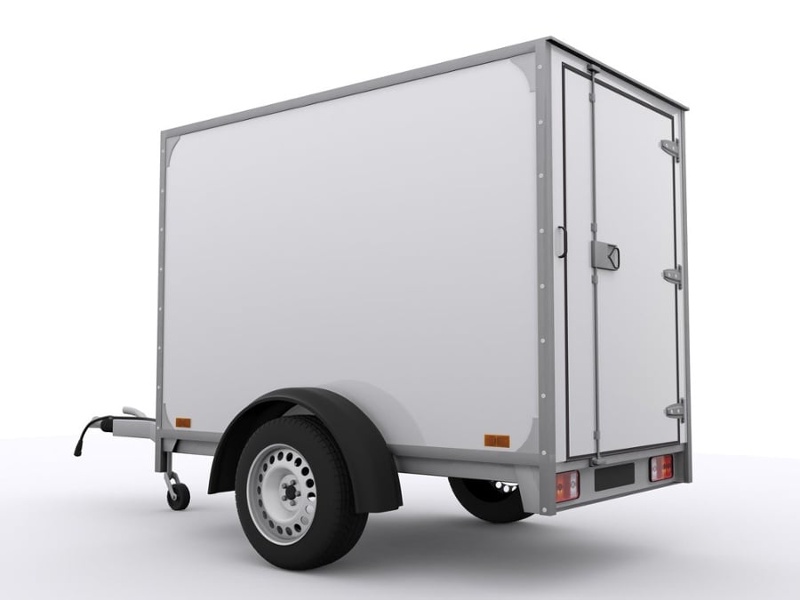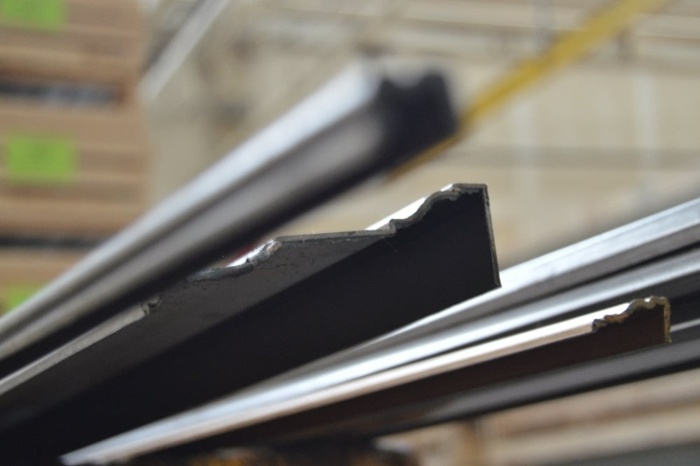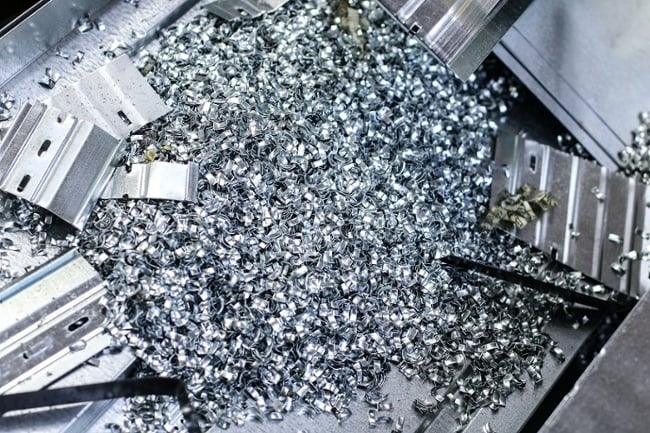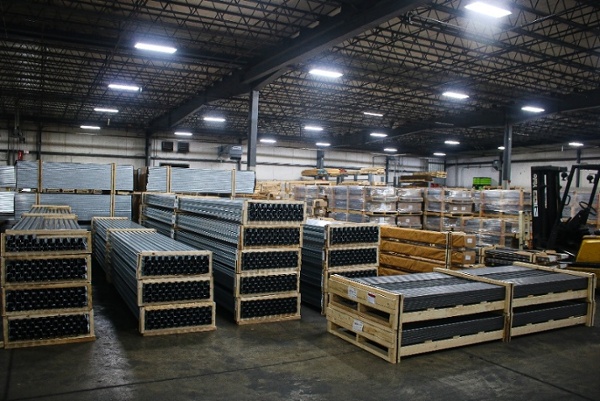A Roll Forming Design Guide for Enclosed Trailer Parts

In the competitive world of trucking, every pound counts.
Creating commercial trailer parts requires balancing innovation, practicality, strength, durability, and cost to ensure optimal performance and affordability. In trailer design, the materials, design choices, and added features can determine the success of the final product.
This is where roll forming comes in. This efficient metalworking process can create lightweight, yet incredibly strong, components for utility trailers, flatbeds, enclosed trailers, and more. From chassis parts to interior framing, roll forming offers a cost-effective solution to meet the demanding needs of the trailer industry.
This guide dives deep into the world of roll forming for commercial trailer components. We'll explore the benefits of using roll-formed parts, the different types of materials available, and the design best practices that can help you create lighter, stronger commercial enclosed trailer parts.
A 7-Step ENCLOSED TRAILER PARTS Design Guide
Building a commercial trailer is a balancing act. You need incredible strength to haul heavy cargo, but every pound adds to fuel costs. This guide dives into the 7 key challenges you'll face when designing lightweight, strong commercial trailer parts using roll forming:
- Material substitutions — strength vs. weight
- Durability and hardness
- Formability issues, including cutoff and springback considerations
- Size
- Complexity
- Additional features
- Aesthetics
1. Material Substitutions
Aluminum is a popular choice for various applications requiring lightweight materials. While steel boasts greater strength than aluminum, the latter surpasses steel in weightlessness. In broad terms (excluding specialized grades), slightly more aluminum is needed to craft a shape with strength comparable to that of steel.
Consider this: A cubic foot of standard-grade aluminum weighs 169 lbs., while a cubic foot of standard-grade steel weighs 490 lbs.
There’s a second balancing act engineers are facing when choosing materials: cost vs. corrosion resistance. Aluminum costs 3.5x as much as steel, but unlike steel, it creates a self-protective layer when exposed to oxygen.
For applications like truck frames and trailers, various aluminum grades are popular, including:
- 2024
- 5052
- 6061
- 6063
Notably, 6061 and 6063 are extrusion-grade aluminum types, challenging to find in coil form, leading roll forming suppliers to steer clear of these grades. Instead, they opt for roll forming-grade aluminum like 5052 and certain 3000 series grades.
But all lightweight component designers already know about aluminum. Let’s talk about something more interesting -- special steels.
Specialty Steels
Engineers have used specialty steels instead of conventional steel for years. These range from HSLA (high-strength low-alloy) steels to UHSS (ultra-high-strength steel) material.
The latter can reach tensile strengths up to 232,000 pounds per square inch (PSI). These steels already contribute to weight reduction efforts in traditional automobiles.
Your application, however, may not require such powerful material. That’s why forward-thinking roll formers are recommending a certain HSLA steel for more and more projects.
80,000 PSI vs. 30,000 PSI Steel in Action
The alloying used to make steel has come a long way. The auto industry has started using much higher-strength steel in chassis components because they can make thinner sections with equal strength.
Now, why would we push for the use of HSLA steel in a project like yours? For the ability to maintain structural integrity while decreasing the amount of material you need.
The video demonstrates the difference between two steels with differing yield strengths — one at 30,000 PSI (30 KSI) and one at 80,000 PSI (80 KSI). As you’ll recall, yield strength is resistance to bending and permanently deforming under stress.
Standard, commercial-grade steel has a PSI of 30,000. It’s pretty low-cost, which explains its popularity. Here’s the problem: It still doesn’t match the cost-effectiveness of 80,000 PSI steel.
You’ll see in the video that there’s some fight in the 30,000 PSI steel … another reason why it’s popular for many fabricated assemblies. But behold the 80,000 PSI steel, which has about the same price per pound. It’s much tougher to bend the shape.
In other words, you might be missing out on a cost-saving opportunity by saying, “But that’s what we’ve always done.” Remember that raw materials can make up 60-70% of the overall price of these parts! Using a little less material goes a long way.
Note that while some metals and plastics have better strength-to-weight ratios than some UHSS and HSLA counterparts, the weight reduction achieved with these materials is almost always offset by higher costs.
2. Other Types of ‘Durability’: Hardness
The concept of "durability" varies depending on who you ask — while corrosion resistance is crucial, there's more to consider. Excessive "durability" can sometimes have negative implications.
For this article, let's focus on two key aspects of durability: strength and hardness. These attributes play a significant role in how collisions impact your trailer. Complexities of collision physics are better left to experts in the field.
What we can share is that, apart from weight, achieving the right properties for enclosed trailer parts often involves a delicate balance between strength and hardness.
Strength
Strength could mean a part is strong enough to be a little flexible so it can withstand constant stress. But it can also mean the product is so stiff it doesn’t “rebound” at all.
Your roll forming supplier should assess the desired metal’s properties and match it up against the complexity of your part’s bends.
An example: A semi-trailer requires a specific aluminum alloy that is strong enough to withstand heavy loads, yet lightweight to improve fuel efficiency. If the aluminum used is too heavy, it could reduce the trailer's payload capacity and increase fuel consumption.
Hardness
Hardness is the ability of a material to, without becoming brittle, resist:
- Surface indentation
- Abrasion
- Erosion
When designing structural metal components for a train, durability usually refers to surface hardness. The metal is case-hardened, heat-treated, and quenched to make the outside ultra-hard. The inside remains softer.
In a vehicle chassis, however, the engineer must design door crossmember frames that maintain their shape under normal driving, but absorb energy during a crash … but not so much that the impact force spreads to the rest of the vehicle.
3. Forming Advanced Materials
Forming higher-strength steels can be a challenge for your roll forming vendor. As long as your partner can accomplish it, your result may be worth the trouble.
In recent years, roll forming has swiped many traditionally stamped jobs in the automotive industry. Your vendor’s (and your design engineer’s) biggest struggles in using high-strength steels will usually be poor flatness and see-sawing mechanical properties.
One way your manufacturer can address this is controlled bending, which guides the material by rollers from both sides along the entire forming line. We’ve seen this produce panel components from martensitic alloy steel with consistent tolerances of 0.02”.
The Cutoff
Along with operator experience and skill, the cut-off press following the forming machine must have the tonnage (force) required to cut each component off at the end of the line.
This means you’ll need to know the material’s yield strength range. A strip of stainless steel might require 2x the force as the same length of mild steel. Your roll forming partner should make you aware if they don’t have a large enough cut-off press or if they decide to pre-punch part of the cut-off before forming allowing a smaller cut-off press to shear the rest.
The Springback Formula
Because you need high-strength materials for trailer parts, you’ll have to deal with springback compensation. Springback is the general distortion of a part after it’s formed. It’s named so because literally, your component springs back toward its old shape.
Materials with higher yield strengths and more springback (stainless steel, structural steels, HSLA steels, etc.) require more work to be formed.
Since this is a fairly predictable outcome, you can work around it. The main predictors of springback are the metal’s yield point (the point at which a metal will stop reverting to its original shape) and elastic modulus (the change in stress with an applied strain).
Here’s a quick bending springback calculator of sorts to get you in the right frame of mind for degrees of “overbend” required. These numbers assume there’s a 1:1 relationship between the metal’s thickness and the part’s inside radius:
- Cold-rolled steel: 0.75 to 1.0°
- Hot-rolled steel: 0.5 to 1.0°
- Mild aluminum: 1.5 to 2°
- 304 stainless steel: 2 to 3°
- Copper: 0.00 to 0.5°
- Brass: 0.00 to 0.5°
Knowing how to make wise springback predictions will help you make better roll form tooling selections, especially for bends with some serious radii.
4. Component Size
The size of a component also plays a role in determining whether it can be run on any particular roll form line. This will vary by contractor, so don’t assume your component is one-size-fits-all.
Before forming, the strip width of the metal required to produce your profile is a significant factor in design-for-manufacturability on a roll forming line. If the strip width is less than the roll space of the shafts, the profile is probably formable for width.
Also, the profile’s final height must be less than the vertical distance between the top and bottom shafts including space for the forming tools themselves. Otherwise, the mill can’t run your profile. As the profile shape gets taller, your supplier will need more tool steel to accommodate the height. In general, the larger the overall area of the profile is, the higher the tooling cost is due to more tool steel required.
5. How Complex Is the Profile?
More non-90 degree bends and larger radii dictate more creative applied forces and more tooling design time.
The more bends a profile has, and the more dramatic those bend angles are, the more forming stations the part will need.
We’ll use extreme examples to drive the point home: Think of an angle profile with short legs (a single, 90° bend angle) requiring only a few passes of tooling. Now for the extreme opposite: A complex profile with 12 or more bends, including hem (180°) bends, would require 20+ passes of tooling and forming stations.
The number of bends in your model determines your roll forming tooling design — and the overall project cost. However, once these tools are designed and tested to complete the complex profile, the forming time is equal to the single bend angle. So in essence, as the parts are formed you get 12+ bends for the same cost as a single bend!
6. Additional Features
Never forget one of the biggest advantages of roll forming: in-line features!
In many cases, components of industrial assemblies have pierced or embossed areas. Most roll forming companies have equipment that includes precision strip feeding and pre-punching to add these types of features to the material either before or after it is formed.
Really, “roll forming” has meant more than just roll forming for decades. Many shops offer in-line auxiliary processes and features such as:
- Embossing
- Piercing
- Welding
- Identification marking
- Tabs, longitudinal bends, edge conditioning.
The capabilities and efficiency of roll forming lines allow for a single, continuous process of interconnected activities starting with a coil of metal on one end and a shipping container at the other end. Keep this, and the ability to add in-line features free of charge, top of mind when considering your lightweight design components. You can get away with more than maybe you’d expect without breaking the bank.
7. Are Aesthetics Important?
Are your trailer parts decorative? Have you ever considered roll forming aesthetic components as an option?
These seem like no-brainers, but in the heat of battle, we sometimes overlook the obvious.
If your part will be public-facing and needs to look good, tell your roll former. The engineers will be able to adjust accordingly and are perfectly capable of giving you a final component free of tooling marks. The smooth polish and gentile radiuses of roll forming tools are especially suited for cosmetic surfaces. For additional protection, consider a peel-off PVC coating on your raw material.
Conversely, if your part will be inside a larger product and will never see the light of day, consider ditching aesthetic touch-ups that drive the price upward.
If you haven’t been considering aesthetics at all, maybe it’s time to start. One increasingly popular use for roll forming is the addition of “retro” decorative elements on the outside of trailers, campers, and other vehicles.
ROLL FORMING ENCLOSED TRAILER PARTS
Today, many high-strength parts are manufactured economically on roll forming lines:
- Bumpers
- Door beams
- Crash tubes
- Rockers
A material’s strength is not a challenge for a roll form machine as long as the tooling design, press punching, and forming steps incorporate the proper forces. As a bonus, roll forming tools can produce millions of parts with minimal wear which maximizes your investment.
To sum it up: Roll forming can be done very successfully if you follow the rules above. Your engineers and the vendor’s engineers should collaborate on a custom solution that allows you to use high-strength steel while reducing your part’s wall thickness. Add inline punching for further process savings. The freedom to design parts of high strength, and lower cost will become evident once the fundamentals of roll forming are applied.
Ready to Partner With an Experienced Roll Forming Company?
Ready to take your trailer component manufacturing to the next level? Contact us today and download our free e-book for even more insights on roll forming design considerations. Let's turn your vision into a reality on the road ahead.
For more advice on roll forming design considerations, download our free e-book below!
(Editor's note: This article was originally published in April 2022 and was recently updated.)
You May Also Like
These Related Stories

Sheet Metal Design Guide: End Distortion & Springback

High-Performance Roll Formed Steel Channels for EMI Shield Enclosures





